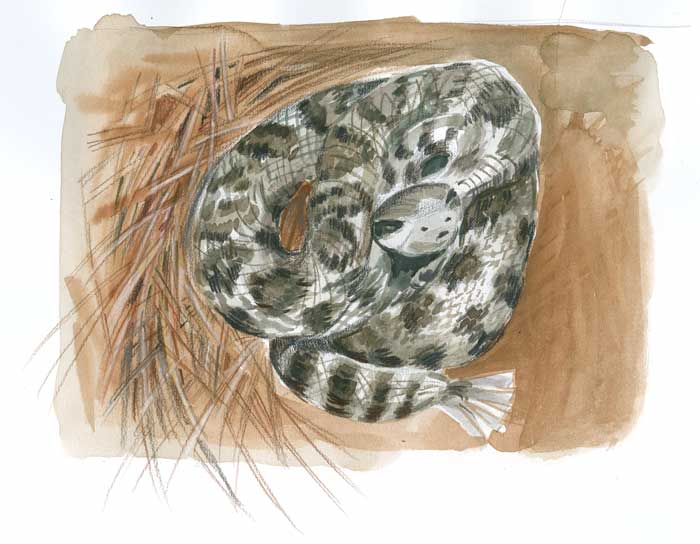You Lookin’ at ME?
Yesterday, after we finished scrambling up and down streambanks and walking over gently sloped hillsides covered with pine straw, my husband and I headed back to the car. He had walked on ahead a few yards and was turned around in my direction when he saw a slithering not far from me. Experienced Boy Scout that he was, he did not yell “look out” or “freeze” or “stand where you are,” he uttered one emphatic word that instantly stopped me in my tracks. “SNAKE.”
I froze and quickly looked around me.
“Where?”
“In front of you and to your left about 7 feet.” Gingerly, I backed up and took the long way back up to the road.
He, of course, the intrepid and curious cameraman, had to investigate.
It was a rattler, and we were the interlopers. We gave the snake space and respect. It had already wound itself up into a neat coil and was ready to defend itself – firstly, by being smaller and inconspicuous, and secondly, if necessary, by striking.
My husband knew, of course, that it could only strike at 2/3 of its length, and it appeared to be about 3 feet in length (he had seen it extended, slithering.)
He offered to take a picture from a safe distance. “Don’t you want to draw it?” he asked.
What a guy! He knew I did.
I nervously hopped on one foot and the other and made frantic little yikesy noises as he approached it to get a better shot for me.
So the snake lived happily ever after and so did my husband, and I have a sketchbook entry to show for it.
From looking at photos on the net, my best guess is that this is a Crotalus oreganus helleri., which looks a lot like your generic diamondback rattler. I read that the western diamondback rattler has now been divided into 7 distinct species, but that taxonomy is disputed. Whatever you want to call it, it is a venomous pit viper, and unlike some other snake species, its babies are born alive and loaded with poison from the get-go.
Rattlers are known to be aggressive. They prey on small rodents, birds and insects, but are themselves vulnerable to birds of prey. Deer, cows and other large mammals will stomp them to death, so they are necessarily fearful of large warm bodies (like ours.)
We couldn’t hear the snake rattling, but the photo showed a blur where a neat tail should be, so I’m guessing that it was quivering slightly.
Did you know that rattlers can SWIM and hold their rattle delicately out of the water when they do? I didn’t know that. I also didn’t know that they often lose their fangs when biting and always have a spare pair in reserve.
I don’t have a fear of snakes, per se, but I do have a healthy respect for them. The sight of one doesn’t send me away screaming and I will gladly hold a small boa or other small non-venomous snake if it is offered. Our son had a green snake named Stretch which I helped care for. So this experience didn’t panic me or discourage me from painting in woods and gullies. But it will certainly teach me to wear hiking boots instead of old sneakers on our next outing.
Tomorrow: a watercolor portrait or a wildflower moment …


